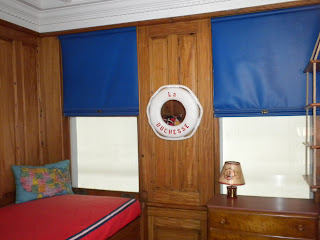As we needed to refuel and wait for a new piece of canvas work, we left Brewerton after noon on another very hot day. Our destination today is Phoenix. After a short run, we will leave the Erie Canal and enter the Oswego Canal which is about 24 miles long and is the conduit to Lake Ontario.
After a quiet night docked on the wall of Lock 7, we left Phoenix on a wet but cooler day for Oswego. Lock 7 is our final lock on the Oswego Canal and our last down lock.
Typical Dam on the side of a lock. Not the right side to go down!
Entering the marina at Oswego on a rainy day. Oswego is a fair sized town. We ambled around the waterfront and ran into some other "Loopers". Had an early dinner in a local seafood restaurant. After checking the weather, we decided to leave the next day for Clayton, NY which is a 7-8 hour run.
Leaving Oswego and the NY Canal system and into Lake Ontario. We have to do a lot more course plotting now as opposed to the canal system which is really just like being on a highway on the river. So we had an exciting moment when our GPS suddenly went off line in the middle of Lake Ontario with no land in sight! Fortunately, Peter quickly tracked down the culprit-a loose connection in the lower level unit-so we were back on track without too much delay.
The weather improved en route to Clayton and the current in the St. Lawrence Waterway gave us a boost so we arrived ahead of schedule. We checked into the French Bay marina which has wonderful facilities. It is more like a country club. We will spend at least 3 nights here.
There is a considerable amount to do and see in Clayton which is considered to be the cultural center and a gateway to the 1,000 Islands. There is even an Opera House here. Actually, there are over 2,000 islands but who's counting. The border between Canada and the US runs between the islands and one has to check into Customs & Immigration if one crosses over into the Canadian side. Since 9/11, both sides of the border have become rather picky about enforcing the regulations which irritates the local fisherman and boaters to no end.
The best way to see the area is from the bow of a boat. However, as there are a lot of shoals and submerged rocks, we decided to sign up for a tour with a local guide. We were lucky to find, Capt. Jeff Garnsey. This is his boat the Muskie which is a 26 ft, 1953 Chris Craft with an oak keel, mahogany planks and a teak deck-a classic. She is the third boat of her kind in the Garnsey family to carry the same name.
Jeff is a retired "bubblehead" (submariner) so he and Peter enjoyed reminiscing about their days in submarines. He family has lived in the area for 8 generations and he gave us a personalized tour and in-depth historical narrative of the river.
Peter enjoying the St. Lawrence River on the Muskie.
US Post Office on the St. Lawrence. The mailman delivers mail to the various islands by boat.
There are some very fancy homes along the river. This is a boat house in the section of the river known as Millionaire's row.
An example of a riverfront home.
In the late 1800's, the 1,000 islands was the summer playground to many wealthy US industrial leaders. One of these was George Boldt. He came to the US in the 1860's from Prussia. From a poor background, he built an enormously successful hotel empire which included the Waldorf Astoria in New York City and the Bellevue-Stratford in Philadelphia.
Boldt purchased large tracts of land and islands along the St. Lawrence including Heart Island where he built a castle for his wife Louise. Unfortunately, she died before the castle was complete and George Boldt halted construction on the castle and never put foot on the island again.
The children's wing of Boldt Castle.
A view of Boldt Castle from the river. The castle was built to resemble a 16th Century Northern European structure. Its massive granite walls rise six stories from the foundation. It has 127 rooms and includes an indoor swimming pool. Despite its size, the castle has an airy and homey atmosphere.
From 1904-1977, Boldt Castle deteriorated into a bad state of repair. The Thousand Island Bridge Authority of NY acquired ownership in 1977 and embarked on an extensive rehabilitation project. Today, all funds generated from tours of the castle are poured back into the ongoing maintenance projects.
Stained glass dome in the central hall.
The Boathouse that was built to accommodate the large steamships that ferried the Boldt family and their guests.
This house on the doorstep of Boldt Castle is affectionately known as the "mother-in-law" apartment.
Clayton is famous for its Antique Boat Museum. We spent an afternoon marveling at their impressive collection of wooden and classic boats. Below are a few examples.
Classic speed and racing boats.
Wooden picnic boats.
Part of their collection includes the 106 ft historic Boldt Boathouse, La Duchesse.
Dining room and fireplace on La Duchesse.



























No comments:
Post a Comment